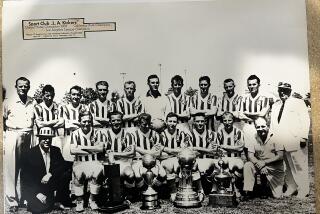Teachers’ Goal Is to Make German Classes a Real Kick
Heather Brown changes into a T-shirt and baggy shorts, laces up her shoes, then jogs over to a soccer field at her Anaheim high school.
It’s time for German class.
Heather is one of hundreds of high school students throughout the western United States whose teachers combine traditional classroom instruction with lessons on the soccer field in an effort to boost the number of students taking German, which lags far behind Spanish and French in enrollment.
“My parents say I’ll never use German in my real life, but it’s been so fun,” Heather said. “The soccer makes it worth it.”
The Transatlantic Soccer Bridge program, which San Francisco’s Goethe Institute launched in Southern California last year, culminates with a soccer tournament Saturday at Heather’s school, Esperanza High.
Teams from 16 schools from Santa Barbara to Placentia will play for the chance to win a summer trip to Germany that includes a stay at a soccer clinic. Esperanza won last year.
With budget cuts threatening the future of specialized courses with smaller enrollments, such as the less popular foreign languages, generating interest in the classes is essential if German is to survive at Esperanza, teacher Liz Kaulard said.
German is the third most popular foreign language in California schools, with about 17,000 students enrolled last year, according to the state’s Department of Education. About 587,000 took Spanish, and 115,000 enrolled in French.
Since the soccer program started, Esperanza’s German enrollment has jumped from 60 to 80 students. Many credited the soccer-focused curriculum with helping them apply the vocabulary and grammar they learn to real life and increasing their comprehension of the language.
“I never would have taken German if soccer wasn’t part of it,” said Heather, 14, who plays on her school’s junior varsity team. “When a class is just about what you learn in the textbook, it can be pretty boring.”
Kaulard knew little about soccer when the program started but gamely recruited a school security officer to coach the team last year and asked an English teacher to volunteer for the post this year.
At the soccer practices, the teens look at first like any other athletic team until one hears the conversations, held in a blend of German and English -- “Tor the ball!” (Kick the ball) “Dude, passen, passen!” (Pass it, pass it.)
The widely varying skill levels mean the more awkward students, panting as they run several yards behind their teammates or missing the ball when they try to kick it, contrast with the six kids who either play club soccer or are on the school’s squads. The rest of the roughly 20 students on the team, dubbed Sturm und Drang after a period of 18th century German literature, fall somewhere in the middle.
Indoors, Kaulard makes students use the language more, but soccer is still the main vehicle for instruction. They learn parts of the body by labeling a drawing of a soccer player then standing for an interactive lesson. When Kaulard calls out “oberschenkel,” the kids point to their thighs; when she says “ferse,” they lift their heels.
Geography is taught through the 18 teams in the Bundesliga, Germany’s elite soccer league. Kaulard gestures to some of the half-dozen jerseys hanging on the walls as she talks about cities such as Stuttgart, Munich and Hamburg.
“I try to teach all the normal stuff through soccer,” she said. “It’s a way of connecting the language to the country’s everyday culture. It’s not enough for me to tell kids to take German because it’s cool. They need something more creative to make them want to be in the class and sustain their interest.”
The students who were taking German before the program started, say the soccer-heavy lessons have made the upper-level classes more fun, with assignments such as composing essays about famous players.
“I took German in the first place because it was kind of off the beaten path, and the soccer thing just makes it even more crazy,” said senior Kyle Parry, 17, who is taking fourth-year German. “Soccer has been the pathway for making me like German a lot more and seeing foreign language as more than just a requirement.”
In addition to Esperanza, the Orange County high schools fielding teams at Saturday’s tournament are Villa Park, El Dorado in Placentia and Sunny Hills in Fullerton. Other teams are Walnut High in the San Gabriel Valley, Warren High in Downey, California High in Whittier, Millikan High in Long Beach, Ayala High in Chino Hills, Chino High, Palos Verdes Peninsula High, Perris High, Bloomington High and Santa Barbara High.
Los Alamitos’ team won an earlier contest in October and will play along with Saturday’s winner in the final round of the tournament, to be held in May in Pleasanton.
The Saturday tournament will be held from 9 a.m. to 4 p.m. at Esperanza High, 1830 Kellogg Ave.





